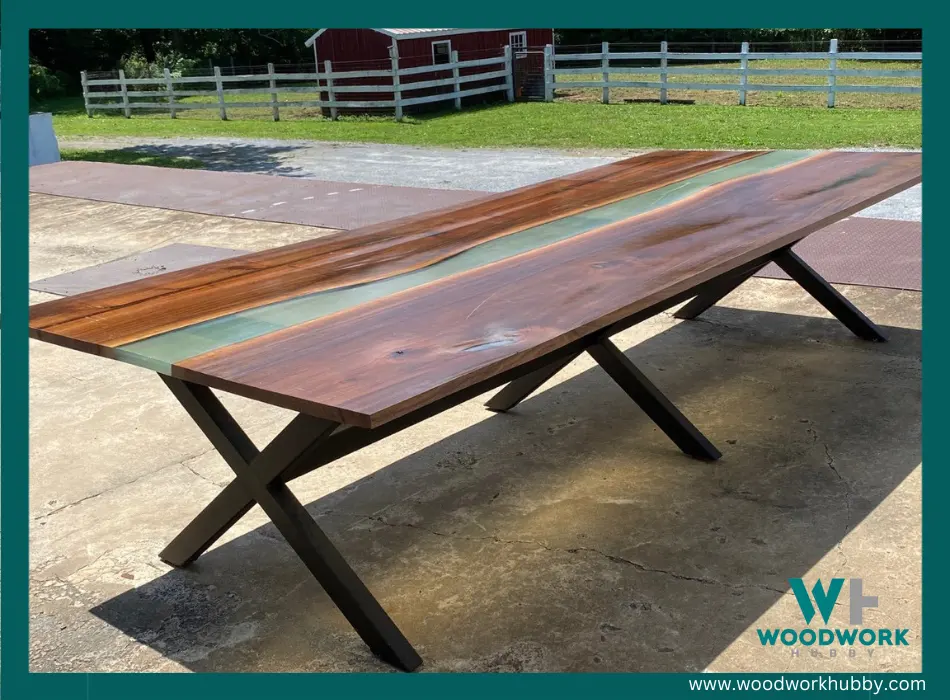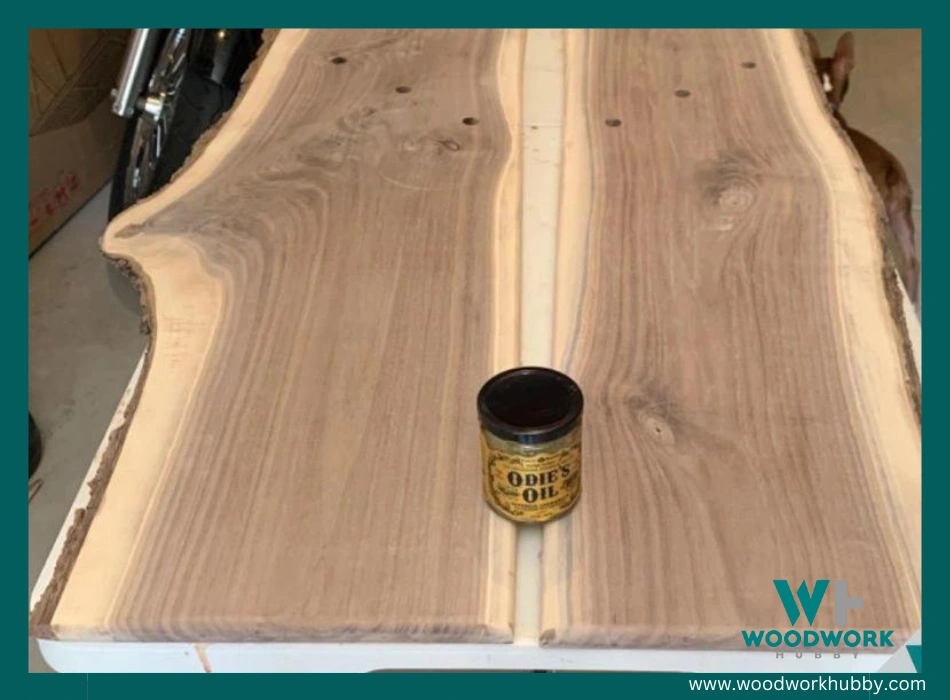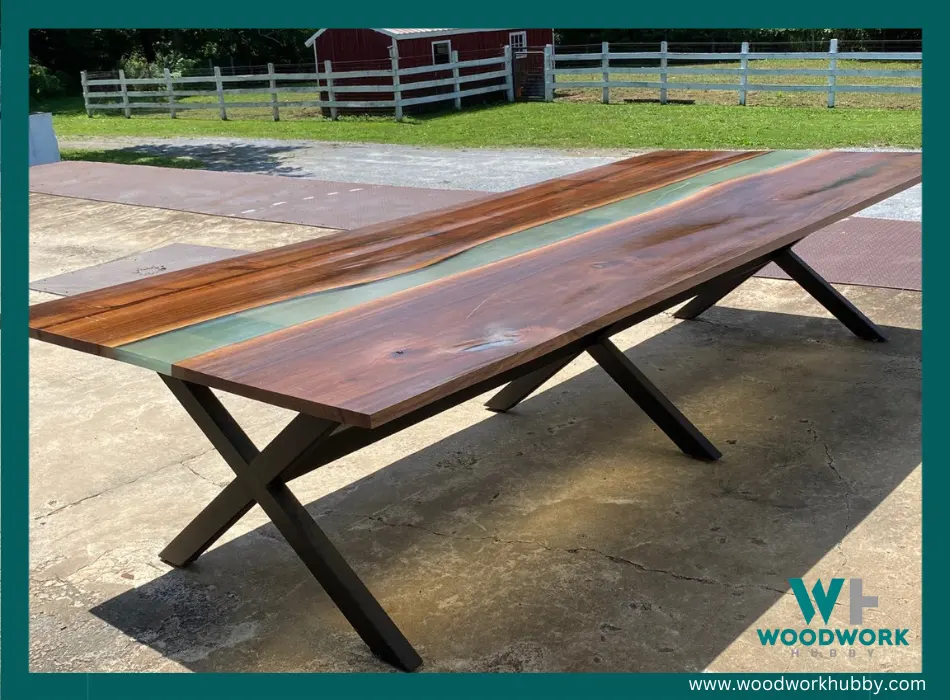Walnut table tops have a very admirable aesthetic, which is also the primary reason for the wood’s selection in this application. But since Walnut can change color over time or appear faded, to begin with, it must be finished right so it can maintain its appearance or look even better.
The best finish for a walnut table top is Odie’s Oil since it brings out the warmth and texture of the walnut table while making it waterproof. It doesn’t contain chemical dryers or preservatives and is hence food-safe and all-natural.
In this article, you will learn more about Odie’s as well as other finishes for a walnut tabletop. You will also learn about the different nuances of each finish alongside the finishing best practices. By the end, you will know what type of finish is ideal for black walnut and butternut.
But before we get into that, here’s a list of all the top finishes for a walnut table top.
- Odie’s Oil
- Rubio Monocoat Walnut
- LinSheen Boiled Linseed Oil
- Watco Danish Oil Natural
- Rust-Oleum Zinsser Sanding Sealer
- Tried & True – Varnish Oil
- Waterlox Original Stain Sealer
- Godora Pure Tung Oil
What Is the Best Finish for a Walnut Table?

A video of a woodworker showing how to make a walnut wood look amazing.
The best finish for a walnut table is an oil-based finish that emphasizes its dark color. This finish can make the walnut table look better, especially when the wood would otherwise fade.
The key properties of a good finish for the walnut table are that it emphasizes the warmth and darkness of the walnut and evens out the contrast between the walnut wood and its corresponding sapwood, which gets lighter over time.
Apart from that, the finish must be durable and should protect the lumber. After all, walnut wood isn’t cheap. With these properties in mind, let’s look at the best walnut tabletop finishes.
Odie’s Oil

Odie’s oil is a classic finish that can be applied to anything from plywood to a leather bag. It dries to a dark and polished finish and has beautifying properties that make it ideal for walnut wood. One of the problems with walnut lumber is that it starts to lose its darkness with age. This is because of UV rays which many oil finishes don’t block. And while water-based finishes have UV ray inhibitors in some cases, they don’t beautify walnut as well.
Odie’s oil contains natural UV-ray inhibitors, which means your walnut table will not start looking dull in a few years. It is worth noting that Odie’s oil coat won’t make your walnut table 100% sunproof, so avoid placing it in direct sunlight anyway.
I particularly like Odie’s oil because it is non-toxic. Since tables are food-adjacent surfaces, it is always possible for food to fall onto the tabletop. A toxic finish is, therefore, a bad idea.
Finally, I like that Odie’s oil is very easy to apply. I say this not as a woodworker with 2 decades of experience but as someone who has seen laymen use Odie’s oil. It really is as simple as rubbing it on with a single handkerchief.
What’s in this oil remains a secret since it is a blend of different natural oils and waxes. But what it does is far from a secret, and there are over 2,900 reviews and ratings to speak for it. The global collective average for these reviews and ratings on Amazon is 4.8 stars on a 5-star scale. And 20 of the reviews actually include the term “walnut.”19 of them are 5-star reviews, and the 3-star review complains about the coverage, stating that the container didn’t have enough oil.
Coming from a universal finish that happens to look good on walnut, we have a finish specifically positioned to look good on walnut. You don’t need to apply multiple coats of this oil, which is why it is called “monocoat.” This saves time but, more importantly, does its job in a single coat.
White walnut can get a warm tint from a single coat of this finish. Despite being marketed as a walnut finish, I have tried this product on different types of wood and have had a great experience.
As mentioned earlier, a finish must have an oil base for it to bring out the best in walnut. This finish has a linseed oil base which has a warming effect over time. This walming effect offsets the fading of walnut over the same period. In the short term, a golden hue is introduced to the lighter walnut, while a darker maple tint is introduced to less bright walnut.
It has over 1,800 reviews and ratings that add up to a global collective average of 4.7 on a 5-star scale. Since this listing is specifically marketed as a walnut finish, most of the reviews are related to walnut lumber use. This makes its average rating even more impressive. 83% of the customers have given it 5 stars, and another 9% have granted it 9 stars.
Overall, it is best on black walnut but can even work on butternut, depending on what you’re looking for. Its durability, sheerness, and ease of application make it one of the top three finishes for walnut table tops.
If your walnut table top doesn’t have some serious flaws, boiled linseed oil can be an excellent finishing option. It is clear yet seeps into the grain and brings out the wood’s natural beauty. More importantly, it strengthens the surface that it is applied. Tabletops are high-traffic surfaces where there is a higher frequency of contact with other objects. While walnut is a tough wood, you probably don’t want it to be worn out with constant use.
The most important aspect of boiled linseed oil is that it can protect untreated wood. Not all boiled linseed oil can, but most formulations include waterproofing agents that prevent rot and insect infestations. Tabletops don’t get termite attacks but can have plenty of water spills, which is why the water resistance of this coat is quite relevant.
It has over 1700 reviews and ratings that collectively add up to 4.7 stars on a 5-star scale. Its water resistance is rated at 4.9 stars, and its ease of use has a 4.8-star rating. That said, I would like to bring the following to your notice.
Since this product features boiled linseed oil, there are drying agents in it that make the overall finish toxic. It is not food safe, especially when curing, and should not be used on Walnut Dining table tops. A coffee table, side table, and drawing room table can all do with a boiled linseed oil top. But for a food adjacent surface, I would use raw linseed oil if I had to use any type of linseed oil. Pure linseed oil takes much longer to cure, though.
Danish Oil is a blend of oils and varnish that dries relatively quickly. It helps the table top become water-resistant but fails to provide consistent protection from heavy use. Danish oil needs to be topped up semi-frequently on high-traffic surfaces.
So why is it among the best finishes for a walnut tabletop? Because it truly beautifies black walnut, introducing warmth to it and bringing out the grain pattern by seeping into it.
It takes 6 hours to dry, and that’s manageable for the average tabletop project. You could be working on the table legs and have the top sealed by the time you’re ready to watch the legs. Even as a customer, you could buy the table and introduce an oomph to its appearance with this oil-based varnish, as it is easy to apply. That said, be prepared to ad multiple coats before you get the right look.
This product has over 500 reviews and ratings that come to a global collective average of 4.8 stars on a 5-star scale. This is self-evidently one of the best ratings for a finish on this list. 96% of the customers have given it 4 or 5 stars, so the odds of you being disappointed with it are relatively low. More specifically, its ease of use is rated at 4.8 stars, while its durability has 4.7 stars.
Rust-Oleum is a brand that is trusted by thousands of woodworkers and handymen around the world. But I’m placing this sanding sealer in my top 8 not because of the brand but because of what it does for walnut. It makes the wood appear more polished with each coat and can be recoated for an added effect.
In fact, re-ups can happen within minutes with very light sanding. It truly seeps in and helps cover and protect the individualized grain and pattern of the walnut lumber. More importantly, it doesn’t darken with age, so the sober appearance it provides stays relatively neutral.
Zinsser Sanding Sealer has over 700 reviews and ratings, averaging 4.7 out of 5 stars. This aligns with my experience with this brand’s products. 92% of its customers have given it 4 or 5 stars, and its highest specific rating is for its “style.” The 4.9-star style rating goes on to show that it is a good-looking finish. Its ease of use and value for money have 4.5 and 4.4 stars, respectively, making it one of the most well-rounded varnishes covered here.
Varnishes are often associated with chemical preservatives and drying agents. That’s why many homeowners avoid varnishing kitchen and dining room tables. If your walnut tabletop is going to come in contact with food regularly, then using Tried & True Varnish Oil is a good idea because it is food safe despite being a varnish.
Its sheen has a range from eggshell to satin, while walnut wood can have a range of lightness. So the two do go together.
The global collective average of this product’s ratings is 4.5 out of 5 stars. More specifically, it has 4.8 stars for its ease of use, which means that not just woodworkers but even customers can finish tables with it. It also has 4.7 stars for durability and 4.5 stars for waterproofing, making it a great choice for tables that are at risk of impact and water spills, respectively.
Waterlox Original Stain Sealer
The level of waterproofing different tabletops provide can vary, and Waterlox is among the top-tier wood sealers in this aspect. When it comes to interior projects, one of the few times when waterproofing matters is on food-adjacent surfaces.
When you apply it to a surface like a tabletop, you don’t worry about water spills. But the reason I recommend it is how it makes the walnut look. It comes in satin as well as gloss options, with the latter dimming by 25% over time. This sealer lacks very little (in that it isn’t all natural) but works well enough, as is evident from its history. Its formula has remained the same since 1910!
This product has over 1500 reviews and ratings that come to an average of 4.8 stars on a 5-star scale. This rating speaks for itself especially when you look at specific aspects like water resistance (rated 4.8 stars), durability (4.7 stars), and ease of cleaning (4.7 stars).
Waterproofing walnut in a way that looks good and is food-safe. That’s what pure Tung Oil does. It seems like there’s always a trade-off between appearance, waterproofing, and food safety. But you can have it all in your walnut table finish as long as you’re willing to adhere to its waiting period. This product is 100% food-safe once it dries and is offered with a money-back guarantee. What way is there for one to go wrong with it?
It has over 230 reviews and ratings that add up to a global collective average of 4.5 stars on a 5-star scale. 86% of the customers have given it 4 stars or 5 stars. It’s pretty decent for tung oil, but 230 reviews don’t form a big enough sample. So I can just go by my personal experience.
How Do You Finish a Walnut Table Top?
You finish a walnut table top by sanding it until it is ready for an oil finish that can seep into the grain, then adding a lacquer or natural oil finish evenly using a drenched rag or a spray. You can then add a water-based varnish on top to add to the table top’s aesthetic effect.
How Do You Finish a Black Walnut Table Top?
You finish a black walnut table top with a coat of Danish Oil. It adds the perfect depth to the table’s grain and protects it against water spills and insect attacks. The finish can be applied with a paintbrush, rag, or spray and must be evened out by hand.
A video tutorial of a woodworker showing two steps to a gorgeous dark brown walnut wood finish.
How Do You Finish a Walnut Slab Table?
To finish a walnut slab table, you need to opt for an oil-based varnish that brings out the darker aspects of the walnut while maintaining an aesthetic contrast with the sapwood. Danish Oil and Tung Oil do a great job in this context.
How Do You Protect a Walnut Table?
You protect a walnut table by coating it in a waterproof sanding sealer and preventing it from being outdoors. Sunlight exposure can make the walnut wood dull but not if you have a UV-inhibiting coat over it. Oldie’s oil helps UV-proof and waterproof a walnut table while making it look good.
What Oil Do You Use on Walnut Wood?
You can use a coat of Oldie’s Oil or Tried & True Varnish Oil on Walnut Wood. Both are natural oil blends that have a polishing effect on Walnut. If you’re open to chemically enhanced varnishes and coats, Rubio’s Monocoat, Danish Oil, and Tung Oil are the oil worth considering for walnut wood.
Best Finish for a Walnut Table Top?
An oil finish with a warm tint is usually the best finish for a walnut table top. If the table is meant for food, it is better to opt for a food-safe finish like Oldie’s Oil or Tried & True Oil Varnish. But if the table is going to be used for work, coffee, or bedside, then most oil varnishes should suffice.
If you want to know if Walnut wood darkens with age, may want to click here for more info.
Final Thoughts – My Top 8 Finishes for Walnut Table Top Durability & Beauty
Walnut wood has a beautiful grain that can be brought out with an oil-based finish that darkens without changing its hue. Tables generally need a food-safe finish. Since Oldie’s oil is an all-natural, waterproofing, food-safe finish, it is ideal for a walnut table top.











